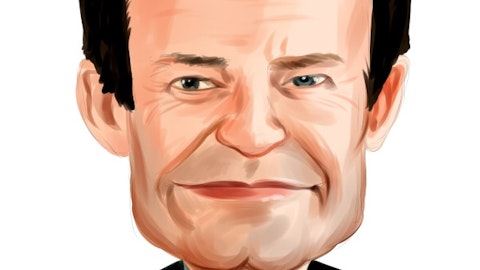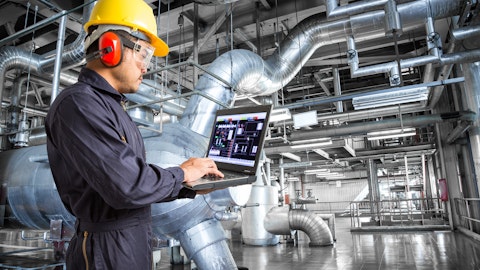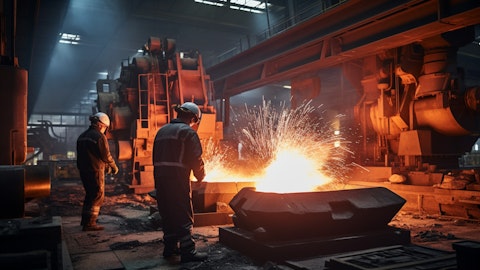William Oplinger: Well, we plan to fulfill the viability agreement and part of the viability agreement is that, we restart 32 pots in the first quarter. However, it does not make economic sense to restart those pots. And the more that we — if we were to restart those pots, they are negative cash flow, and it will just simply consume cash out of the entities quicker than if we were not restarting those spots. So at this point we will be having the discussions with all the parties involved and make sure they understand that starting those pots will consume cash and there is only a limited amount of cash available in the entities and once that cash is gone Alcoa does not plan to put further cash into the entities.
Carlos De Alba: Fair enough. If I may just squeeze one more. The $70 million benefit from the closure of Kwinana starting in the third quarter, are those net of the purchases that you have to make in the market to fulfill your customer contracts?
Molly Beerman: So, Carlos, the $70 million is the Kwinana loss elimination. We will have some costs to replace, basically purchase the committed alumina for customers. That’s part of our overall trading activity and we do not see a material impact there.
Carlos De Alba: All right. Fair enough. Thank you very much, Molly and Bill.
William Oplinger: Thank you, Carlos.
Operator: And our next question today comes from Katja Jancic with BMO Capital Markets. Please go ahead.
Katja Jancic: Hi. Thank you for taking my questions. Can you quickly provide an update on the Alumar smelter restart?
William Oplinger: Yes. So as we said in the fourth quarter, we’re taking the Alumar smelter restart slowly and at a measured pace. We have increased the amount of pots operating too, as of today to approximately 70% of the plant and we’re making slow, but good progress on restarting the smelter. So, while I would wish it was faster, we want to do it safely, we want to do it economically and we want to do it in a way that positions the asset for the long term and so we continue to make progress.
Katja Jancic: And is the $75 million, is that expected to also occur in 2024 benefits?
Molly Beerman: Yes, Katja, you will see the $74 million come in over time. So that would be a run rate by the time we get to the end of 2025.
Katja Jancic: Okay. And just one more question, if I may. On — going back to San Ciprian, are there specific reasons why you can’t just shut it down now?
William Oplinger: The smelter, as you know, obviously is curtailed today. The refinery is at 50% capacity. If we chose to go to a full curtailment, we would have to go through the process of negotiating with the unions on a curtailment. And that may be a consideration. We’ll be looking at all options at this point to conserve cash out of that entity.
Katja Jancic: Okay. Thank you.
Operator: And our next question today comes from Timna Tanners with Wolf Research. Please go ahead.
Timna Tanners: Yes, thanks for taking that question and a happy New Year. I wanted to ask about the comment on ELYSIS and how there wasn’t any required spending to the end of the decade. I [indiscernible] that was a change from the past, I thought. At your last Investor Day there had been a lot of talk of ELYSIS [Indiscernible] refinery of the future investments. And I’m just wondering if you could provide us an update on that broadly.
William Oplinger: So I’ll take a first cut at that and then Molly can jump in if you want to add anything. Timna, we continue to make progress with our partners and ELYSIS on the process. And we have plans to start a commercial size cell at the Alma smelter in Quebec in 2024. So we are continuing to make progress. However, we are not planning on an implementation in the near term of ELYSIS. We’re going to allow for ELYSIS to go through some of the testing process and ensure that we have the right package of engineering. And so at this point, we’re not planning on significant investments in an ELYSIS cutover or on ELYSIS plant this part in this decade. So it would be earlier next decade. Is that a change? It’s an R&D project, and we’re working through that R&D and ensuring that the process works well. And we’ll implement it later in the decade, early next decade.
Timna Tanners: Okay, thanks. And then regarding possible other portfolio changes, I know you’ve talked about Lista in the past is, at these aluminum prices, any thinking about its viability and similarly anything that you could tweak beyond the Warrick restart, given the 45X benefits?
William Oplinger: Well, to give you a little bit of perspective of some of the things that we’ve had going on, we mentioned the Warrick restart, and so we got half of that done in the fourth quarter. I plan on getting the other half of that done in the first quarter. We’ve made the announcement around Kwinana. So that will be in 2024. We continue to make progress around Alumar. And so, we have that restart going on. And we have engagement on all the pertinent issues in Spain. And so we have that going on. At this point, Tim, that’s a lot to get done. And I think the team has done a great job of initiating all of that. We will consider, as we always do, asset by asset, does it make sense to start, stop all those options. And we make it on a fairly real-time basis. And where we have spot power exposure, we make those decisions on a real-time basis. So we’re always considering some of those portfolio options, specifically around high-cost facilities like Lista.





